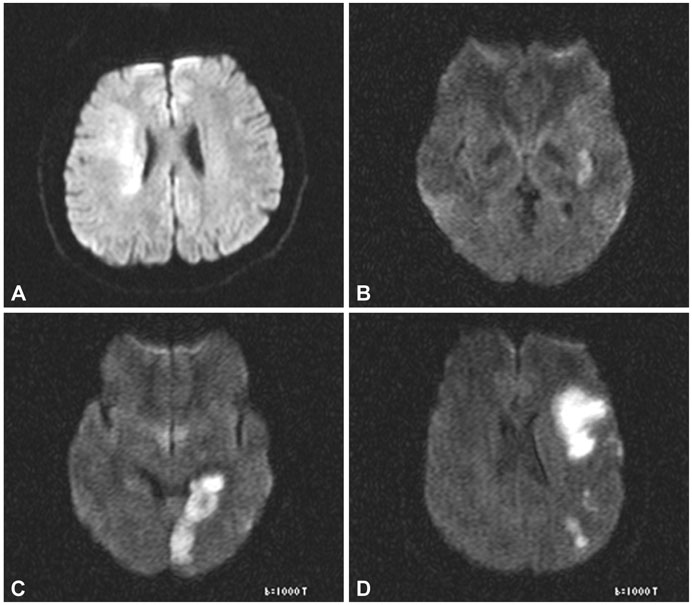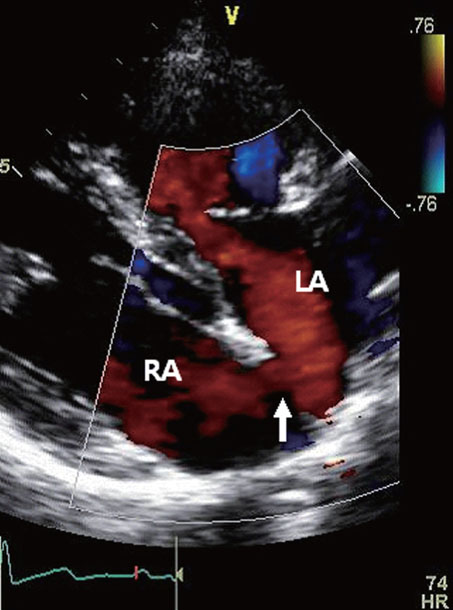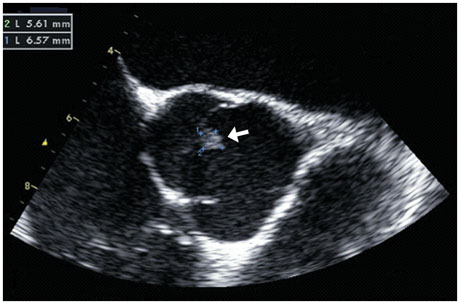J Clin Neurol.
2010 Dec;6(4):212-215. 10.3988/jcn.2010.6.4.212.
Transient Increase in Intrathoracic Pressure as a Contributing Factor to Cardioembolic Stroke
- Affiliations
-
- 1Department of Neurology, Guro Hospital, College of Medicine, Korea University, Seoul, Korea. nukseo@korea.ac.kr
- KMID: 1462809
- DOI: http://doi.org/10.3988/jcn.2010.6.4.212
Abstract
- BACKGROUND
The hemodynamic effects of increased intrathoracic pressure (ITP) have been the focus of many investigations. However, very little is known about the effects of elevated ITP on the occurrence of stroke.
CASE REPORT
Four young patients with a cardioembolic source of stroke were examined. In all cases the stroke was preceded by an increase in ITP that occurred during coughing, vomiting, or sexual intercourse.
CONCLUSIONS
We suggest that cardioembolic stroke is facilitated by situations in which ITP is elevated.
Keyword
Figure
Reference
-
1. Sharpey-Schafer EP. Effects of Valsalva's manoeuvre on the normal and failing circulation. Br Med J. 1955. 1:693–695.2. Uwatoko T, Toyoda K, Fujimoto S, Yasaka M, Ibayashi S, Iida M, et al. [Behavioral situation at onset of paradoxical brain embolism due to patent foramen ovale]. Rinsho Shinkeigaku. 2004. 44:503–507.3. Evers S, Henningsen H, Ringelstein EB. Transient ischemic attacks caused by trumpet playing. Neurology. 1998. 51:1709–1710.
Article4. Becker K, Skalabrin E, Hallam D, Gill E. Ischemic stroke during sexual intercourse: a report of 4 cases in persons with patent foramen ovale. Arch Neurol. 2004. 61:1114–1116.5. Head CE, Thorne SA. Congenital heart disease in pregnancy. Postgrad Med J. 2005. 81:292–298.
Article6. Okayasu H, Wakayama Y, Takahashi H, Jimi T. [A case of cough hemiplegia]. Rinsho Shinkeigaku. 1993. 33:740–745.7. Tiecks FP, Lam AM, Matta BF, Strebel S, Douville C, Newell DW. Effects of the valsalva maneuver on cerebral circulation in healthy adults. A transcranial Doppler Study. Stroke. 1995. 26:1386–1392.
Article8. Caplan LR, Hennerici M. Impaired clearance of emboli (washout) is an important link between hypoperfusion, embolism, and ischemic stroke. Arch Neurol. 1998. 55:1475–1482.
Article9. Gray C, Ward JF, Sands JP. Syncope from increased ventricular response in atrial fibrillation during voiding: a new indication for surgical management in benign prostatic hyperplasia. J Urol. 1999. 161:606–607.
Article10. Nagayoshi H, Janota T, Hnatkova K, Camm AJ, Malik M. Autonomic modulation of ventricular rate in atrial fibrillation. Am J Physiol. 1997. 272:H1643–H1649.
Article
- Full Text Links
- Actions
-
Cited
- CITED
-
- Close
- Share
- Similar articles
-
- The Association between Neurological Prognosis and Serum Glucose Level by Stroke Subtype in Acute Ischemic Stroke
- Effects of Gamma-Glutamyl Transferase on Stroke Occurrence Mediated by Atrial Fibrillation
- The change of stroke volume variation during thoracotomy or one lung ventilation
- Stroke Update: Optimal Blood Pressure Management for Stroke Prevention
- Risk Factors for Acute Cardioembolic Brain Stroke in Acute Myocardial Infarction




